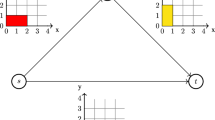Abstract
Strang (Mathematical Programming 26, 1983) gave a method to establish a max-flow min-cut theorem in a domain of a Euclidean space. The method can be applied also to max-flow min-cut problems defined by Iri (Survey of Mathematical Programming, North-Holland, 1979) whenever the capacity functions of max-flow problems are bounded and continuous. This paper deals with max-flow min-cut problems of Strang and Iri with unbounded or noncontinuous capacity functions. It is proved that, in such problems, max-flow min-cut theorems may fail to hold.
Similar content being viewed by others
References
R.A. Adams,Sobolev Spaces (Academic Press, New York, 1975).
E.J. Anderson and P. Nash,Linear Programming in Infinite Dimensional Spaces (Wiley, Chichester, 1987).
W. Blum, “A measure-theoretical max-flow—min-cut problem,”Mathematische Zeitschrift 205 (1990) 451–470.
C. Castaing and M. Valadier,Convex Analysis and Measurable Multifunctions. Lecture Notes in Mathematics No. 580 (Springer, New York, 1977).
K. Fan, “Minimax theorems,”Proceeding of the National Academy of Sciences of the U.S.A. 39 (1953) 42–47.
L.R. Ford and D.R. Fulkerson,Flows in Networks (Princeton University Press, Princeton, NJ, 1962).
E. Giusti,Minimal Surfaces and Functions of Bounded Variation (Birkhäuser, Basel, 1984).
T.C. Hu,Integer Programming and Network Flows (Addison-Wesley, Massachusetts, 1969).
M. Iri,Network Flow, Transportation and Scheduling — Theory and Algorithms (Academic Press, New York, 1969).
M. Iri, “Theory of flows in continua as approximation to flows in networks,” in: A. Prekopa, ed.,Survey of Mathematical Programming (North-Holland, Amsterdam, 1979) pp. 263–278.
K. Jacobs and G. Seiffert, “A measure-theoretical max-flow problem, part I,”Bulletin of the Institute of Mathematics Academia Sinica 11 (1983) 261–280.
R. Kohn and R. Temam, “Dual spaces of stresses and strains, with applications to Hencky plasticity,”Applied Mathematics and Optimization 10 (1983) 1–35.
W. Maz'ja,Sobolev Spaces (Springer, Berlin, 1985).
M.H.A. Newman,Elements of the Topology of Plane Sets of Points (Cambridge University Press, London, 1954).
R. Nozawa, “Max-flow min-cut theorem in an anisotropic network,”Osaka Journal of Mathematics 27 (1990) 805–842.
M. Ohtsuka,Perimeter. Lecture Notes (Gakushuin University, Tokyo, 1983).
A.B. Philpott, “Algorithms for continuous network flow problems,” Ph.D. thesis, University of Cambridge (Cambridge, 1982).
G. Strang, “Maximal flow through a domain,”Mathematical Programming 26 (1983) 123–143.
A. Taguchi and M. Iri, “Continuum approximation to dense networks and its application to the analysis of urban road networks,”Mathematical Programming Study 20 (1982) 178–217.
Author information
Authors and Affiliations
Rights and permissions
About this article
Cite this article
Nozawa, R. Examples of max-flow and min-cut problems with duality gaps in continuous networks. Mathematical Programming 63, 213–234 (1994). https://doi.org/10.1007/BF01582067
Received:
Revised:
Issue Date:
DOI: https://doi.org/10.1007/BF01582067




